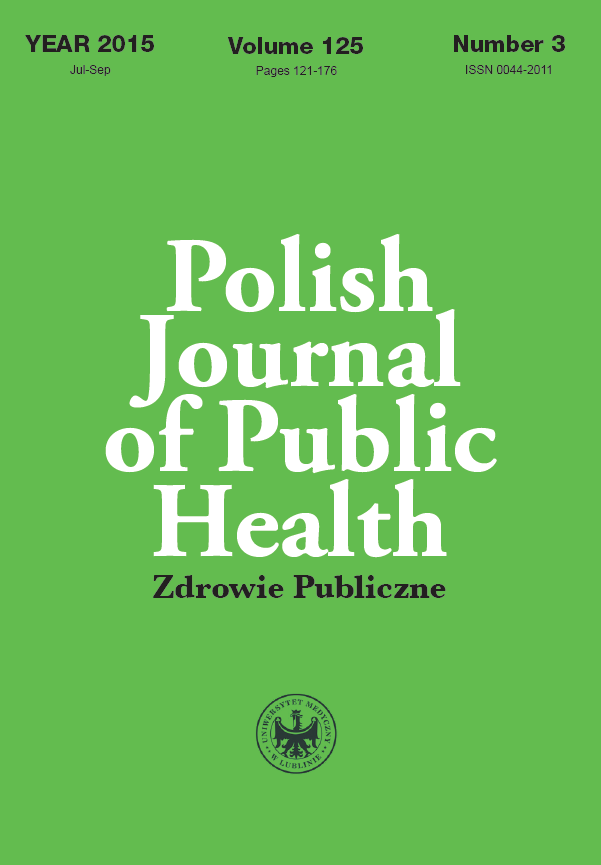Knowledge of contraceptive methods among adolescents/young adults
DOI:
https://doi.org/10.1515/pjph-2015-0042Keywords:
contraceptives, post middle school adolescents, start of sexual life, familyAbstract
Introduction. Family planning methods let one make an informed decision about having children at the right time. People have been trying to adopt the right family planning methods for centuries, mainly through using various contraceptives. These used to be very diverse over the time, yet the goal remained the same – preventing pregnancy.
Aim. Assessment of the factors affecting the knowledge and prevalence of contraceptive methods, as well as the factors affecting sexual behavior of adolescents/young adults.
Material and methods. 219 individuals (111 women and 108 men) between 17-21 years of age, attending secondary schools, participated in this voluntary and anonymous study. A survey questionnaire prepared by the authors was used as a study tool. Statistical analysis of the data obtained was performed using the SPSS 17.0 software.
Results. 81% of the adolescents/young adults stated that their knowledge of contraception is sufficient for them to be in charge of their own sexual lives, whilst some 9% mentioned that they lacked such knowledge, 85% of the young people studied stated that they were interested in contraception. The main sources of knowledge about contraception are the Internet (35%) and peers (22%). The survey showed that 59% of the individuals correctly answered the question regarding the length of a woman’s menstrual cycle, 77% correctly defined the first day of the cycle, and 49% correctly determined the time of ovulation. The studied group of people had difficulties determining menstrual cycle phases; 23% considered them as fixed, 27% – that they are variable, and 29% gave the correct answer. The surveyed people thought that contraceptive method effectiveness (43%), availability (33%) and ease of administration (17%) are most important when choosing the method. Condoms are the most common (72%) contraceptive method among the surveyed people while hormonal contraceptives and interrupted intercourse are poorly known (12% and 11%, respectively). The respondents deemed the hormonal method (50%), and intrauterine contraceptive methods (21%) and condoms (21%) the most effective modes of contraception. They thought that interrupted intercourse (53%) and natural birth control methods (34%) are the least effective. The age at which most of the respondents started their sexual life ranged between 16 and 18; with the age of 16 being the most common (24.2%). Some 40% of the surveyed called their sexual intercourse occasional.
Conclusions. Adolescents consider both the Internet and their peers the primary source of information about sexuality, family planning or birth control methods. The average age of the first sexual experiences has been gradually decreasing and the condom remains to be the most common method of contraception for adolescents/young adults. The knowledge concerning family is insufficient and frequently inaccurate. Education in the fields of sexuality, contraceptive and family planning methods should be included in primary school curriculum.
References
1. Jarząbek G, Pawelczyk M, Friebe Z. History of family planning and contraceptive methods. Ginekol Prakt. 2006;3:30-3.
2. Kiełbasińska J, Dmoch-Gejzerska E. History of conception regulation. Poł Nauk Prakt. 2008;1:50-2.
3. Złotowicz-Grochowska R. Contemporary hormonal contraceptives. Farmakol Farmakoter. 2007;8:33-7.
4. Nowosielski K, Drosdzol A, Skrzypulec V, et al. Sex in young adults of Silesian Province. Ginekol Parakt. 2005;2:32-39.
5. Woynarowska B. Health Education. Warszawa: Wydawnictwo Naukowe PWN; 2008.
6. Jakimiuk A, Nowicka M. Contraceptives in adolescents. Ginekol po Dyplomie. 2007;4:28-41.
7. Huras H, Prażmowska B, Klimek M. Middle school student knowledge level of family planning methods. Poł Nauk Prakt. 2009;4:8-11.
8. Filipp E, Pawłowska A, Wilczyńska A, et al. Family planning methods among female teenagers. Gin Prakt. 2005;4:46-52.
9. Sajdak S, Łukaszczyk I, Ziętkowski W. Evaluation of the start of adolescence sexual presently. Med Wieku Rozw. 2000;2:177-83.
10. Woynowska B, Małakowska A, Tabak I. Sexual behaviour among 16- and 18-year-old adolescents in Poland in 2005. Ginekol Pol.2006;9:667-77.
11. Płocka-Molińska M, Moś K. Knowledge and use of contraceptive methods among secondary school students. Pol Med Rodz. 2004;1:465-7.
Downloads
Published
Issue
Section
License
Copyright (c) 2015 Polish Journal of Public Health

This work is licensed under a Creative Commons Attribution-NonCommercial-NoDerivatives 3.0 Unported License.


